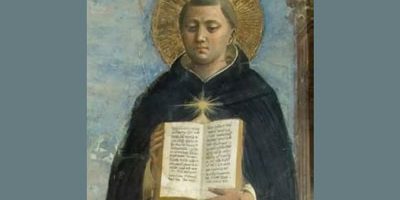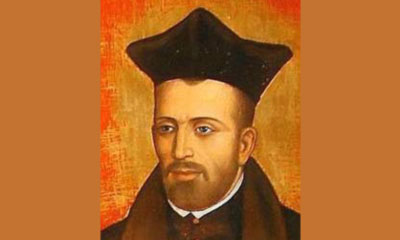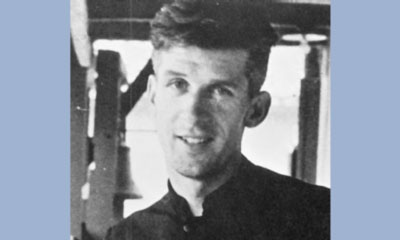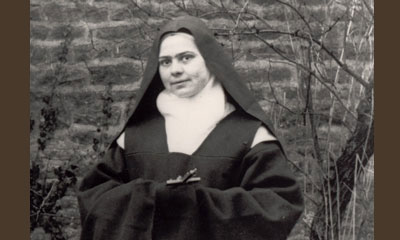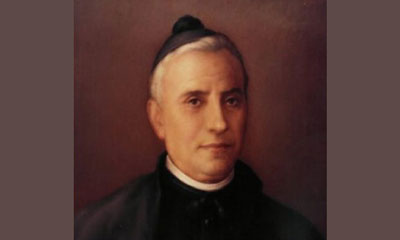March 8, 2017
Saint Thomas Aquinas
Dear Friends,
Around 1244, in the castle of Roccasecca in Campagna, at the time part of the kingdom of the Two Sicilies, Lady Theodora was worried. A servant had informed her that her son Thomas, then a student at the Imperial Academy in Naples, had just taken the black and white habit of a new community of mendicants that had recently been founded. This son was supposed to become the Lord Abbot of Monte Cassino, and here he was begging for his bread in the streets like a pauper. He was bringing shame upon the entire family as well as himself! Consumed with these thoughts, the countess took off at the head of an escort for Naples at full gallop to bring him back to his duty. In vain! He had already left the city… This prodigal son, who seemed a threat to the Aquinas family’s good name, would instead be its glory, for his holiness and knowledge would illumine the universal Church up to the present day.
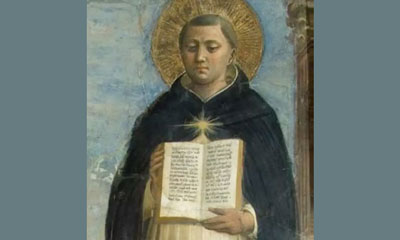 Thomas was born around 1225, the last child of Count Landolph of Aquinas, related to the imperial Hohenstaufen family, and Theodora of Theate, of Norman descent. The noble Aquinas family were vassals of Emperor Frederick II, who had been crowned by Pope Innocent III. Raynaldo and Landulph, the elder sons, would be imperial officers until the Hohenstaufen were deposed by Innocent IV in 1245. Both would die in defense of the papacy. The count set his heart on his youngest son assuming the honorable position of Abbot of Monte Cassino. So he entrusted him to the Benedictine monastery as an oblate at the age of five, to receive a first-class education at the abbey. Perhaps in doing so, Landolph wished to express his repentance, for several years earlier he had taken part in the monastery’s destruction, under order of the Emperor. Thomas was awestruck at the monks’ lifestyle. Everything left a profound impression on him—the calm, the silent prayer, the study, the divine office that always began with: Deus, in adjutorium meum intende (God, come to my assistance!). A question formed in the child’s mind: what is God?
Thomas was born around 1225, the last child of Count Landolph of Aquinas, related to the imperial Hohenstaufen family, and Theodora of Theate, of Norman descent. The noble Aquinas family were vassals of Emperor Frederick II, who had been crowned by Pope Innocent III. Raynaldo and Landulph, the elder sons, would be imperial officers until the Hohenstaufen were deposed by Innocent IV in 1245. Both would die in defense of the papacy. The count set his heart on his youngest son assuming the honorable position of Abbot of Monte Cassino. So he entrusted him to the Benedictine monastery as an oblate at the age of five, to receive a first-class education at the abbey. Perhaps in doing so, Landolph wished to express his repentance, for several years earlier he had taken part in the monastery’s destruction, under order of the Emperor. Thomas was awestruck at the monks’ lifestyle. Everything left a profound impression on him—the calm, the silent prayer, the study, the divine office that always began with: Deus, in adjutorium meum intende (God, come to my assistance!). A question formed in the child’s mind: what is God?
Pass on to others
But once again, Frederick II threatened Monte Cassino. So fifteen-year-old Thomas was sent away to study in Naples. There he met some poor monks, learned and pious, members of the Order of Preachers, which had continued to grow since their founding by Dominic de Guzmán in 1216. Won over by the evangelical poverty of this Order and by its ideal of passing on to others the fruits of contemplation (“contemplata aliis tradere”), Thomas asked to take the habit. He was twenty years old. His rectitude and the firmness of his will, as well as his penetrating intelligence and his accurate, reliable memory led them to make an exception in his case, and the Order agreed to admit him. His superiors, foreseeing a fierce reaction from his family, sent him to Rome. Seeking to retrieve her son, Lady Theodora requested an audience with the Pope. The Supreme Pontiff tried in vain to dissuade her from this plan. She then turned to her two eldest sons, ordering them to bring her back their brother. Soon Raynaldo and Landulf, having tracked down their brother, tried to rip his habit off his back. But they were unable to, owing to his height and imposing stature. They then threw him on a horse that left immediately for the Castle of Monte San Giovanni, a veritable eagle’s nest that belonged to the Aquinas family. Secluded, but well-treated, Thomas by turns endured flattery, threats, and promises from his mother, and then from his three sisters, who brought him his meals with the mission of distracting him and convincing him to abandon his unthinkable plan. Not drawing the line at anything, the two brothers sent a prostitute to the imprisoned novice’s room one night. Thomas got out of bed, seized a burning log in the fireplace, and with a solemn expression, marched resolutely toward the poor girl who ran away terrified. On the door that he had just shut, Thomas traced a large sign of the cross with the firebrand that he then calmly placed back in the fireplace. According to tradition, that very night he received assurance of his perpetual chastity. From that time on, Thomas’ imprisonment became less strict. His sisters, who loved him dearly, brought him a Bible—he would learn it by heart—and several books of theology and philosophy. Marotta, the eldest, would become a Benedictine nun, then abbess of the Monastery of Santa Maria in Capua. Adelasia and Theodora would lead holy lives in marriage. Thanks to them, Thomas regained contact with the Dominicans and, eventually, escaped after more than a year in captivity.
The “dumb ox”
Around 1245, Thomas went with the Master of the Order, Johannes Teutonicus, to Paris to follow Saint Albert the Great’s theology lectures. In 1248, he went to Cologne, where he would be ordained a priest. Before long, the young boisterous students had made Thomas, their sober and studious fellow student, the target of their jests. They nicknamed him “the big dumb ox.” Nevertheless, the young Dominican was not without a retort. One day, the others called to him at the window saying, “Look, Brother Thomas, a flying ox!” And all roared with laughter when he had the naiveté to come see it. The retort was stinging: “It seems to me more likely to see an ox fly than monks lie!” A fellow student offered to help this “dumb ox” understand a class that had just been given, but he himself ended up muddled in his explanations. Thomas then gently picked up where his impromptu teacher had left off, identified the error, and took up the question again with clarity, opening new perspectives to his fellow student. The latter, confused but admiring, immediately asked that Thomas repeat the explanation for his benefit. Little by little, Thomas’ reputation spread. Thomas was kind and agreeable towards everyone, even though he often seemed lost in his thoughts. One day Master Albert prophesied, from the height of his pulpit: “You call him the dumb ox, but I tell you one day the bellow of his teaching will shake the world.” And he asked Brother Thomas to expound upon a subtle point in the book The Divine Names by Dionysius the Areopagite. Having prepared himself with prayer, the brother gave a brilliant lecture. “You speak more like a master teaching,” Albert told him, “than a student being examined.” “I really do not see how to present it any other way,” the student modestly excused himself.
In 1252, Thomas was, in spite of his youth, proposed to become a master at the University of Paris. After providing commentary on the prophets Jeremiah and Isaiah, he explicated the Books of Sentences by Peter Lombard (a theologian who had been the Bishop of Paris from 1159 to 1160), the fundamental theological manual in universities during the Middle Ages. He became the regent master at the College of Saint James in 1256. Thomas, who was not the required thirty-five years old, tried to turn down the honor that was being bestowed on him on the basis of his age, but the rector obtained a formal order from the Dominican hierarchy and the monk humbly accepted. Not having a topic for his inaugural homily, he spent the night in prayer. A venerable unknown Dominican appeared before him and told him to preach on verse 13 of Psalm 103 [104]: Rigans montes de superioribus suis… From Thy lofty abode Thou waterest the mountains; the earth is satisfied with the fruit of Thy work. Thomas commented on this verse, explaining that the wisdom of a master in theology can come only from God, Who conveys it through intermediaries: “Assuredly,” he said, “no one could pretend to possess in himself and by his own means sufficient ability to fulfill such a ministry. But one may hope for this ability from God: Not that we are sufficient of ourselves to claim anything as coming from us; our sufficiency is from God (2 Cor. 3:5). But to obtain it from God, one must ask Him for it: If any of you lacks wisdom, let him ask God, Who gives to all men generously and without reproaching, and it will be given him (Jas. 1:5). Let us pray to Christ that He might deign to grant it to us. Amen.”
Bringing the truth into the light
The task of the master in theology is first to comment on Holy Scripture, then to discuss difficult questions so as to shed light on them, and lastly to preach before the people and the assembled university. In nearly all of his works, Saint Thomas used the scholastic method: a complete and systematic presentation of each problem, considering all the diverse opinions. The truth is brought into the light and stripped of the errors that obscure it. In addition to lectures on particular themes, developed through exchanges between a master and his students, public talks were also organized where anyone could ask questions on any subject. These sessions were formidable because competing masters often tried to make difficulties for the speaker.
Thomas Aquinas’ literary fecundity is impressive. In addition to his courses and homilies, he wrote many other works at the request of brothers, bishops, even the Pope, or simply for personal study. The saint’s organization and lucidity of thought, combined with an uncommon ability to concentrate, allowed him at times to dictate four very different works to four secretaries simultaneously. Far from priding himself on his abilities, Thomas placed them in the service of knowledge of God and His plan for creation. For him, the whole purpose of theology lies in the question of eternal salvation, the ultimate end of man’s life. Theology includes the vision of God in eternity, which is totally beyond the natural abilities of man. Man is therefore dependent upon a light higher than that of simple human reason—he needs divine light to discover the way that leads to the ultimate goal, and also to better know the truth of the things of this world. Revealed doctrine that gives us this light and informs us on the vital and decisive question for our lives, eternal salvation, is more important than any other human knowledge. It is called theology, literally the knowledge of divine things.
It was not long before an open persecution by secular masters at the university disturbed Thomas’ studious activity. William of Saint-Amour and Siger of Brabant published a libelous attack on the mendicant Orders (Dominicans and Franciscans), called such because their members depended on the generosity of the faithful for their sustenance, as all their time was consumed in the study and teaching of the sacred sciences. Jealousy lay behind this attack against the religious whose reputation for learning was only growing. Thomas endured these power hungry men, who were hindering his professorial career, with humility and gentleness. But the day came when the legitimacy of the Dominican Order and its right to teach were challenged before the Pope. Thomas was then directed by his superiors to defend them. After praying at length, he analyzed the “Tract on the Dangers of the Last Days” by William of Saint-Amour, a work not without malice, duplicity, and perfidiousness, and published his response in the Contra impugnantes (“Refutation of those who attack the worship owed to God and the religious life”). He first showed that teaching theology is a work of mercy because it shows man the way to eternal salvation, and thus can serve as the foundational purpose of a religious Order. He then defended the legitimacy of it being a mendicant order, which allows its members to more closely follow Christ. In the end, William was condemned by the Pope and banned from the university. Without ever deviating from the truth, Thomas always retained a great courtesy and perfect self-control toward his contradictors. He even remained grateful to them, because he believed “there is no better means to reveal the truth and hold error in check than to argue with those who are not in agreement with you.”
A saint described by a saint
Saint Thomas was officially admitted into the body of masters at the University of Paris in 1257, along with Saint Bonaventure, his Franciscan colleague and friend. The two saints thought very highly of one another. Once when Thomas made a visit to Bonaventure he found him in an ecstasy, absorbed in writing the life of Saint Francis. Immediately taking his leave, he murmured to a friar he came across: “Let us leave a saint to write the life of a saint!” In the difficulties he encountered, Thomas turned to prayer. He composed numerous prayers asking for God’s light in his intellectual work, and always began by imploring the Spirit of God before setting to work. His confrere, collaborator, and confidant, Reginald of Piperno, related that after having fasted and prayed several days in the face of a difficulty in explicating a passage from the Prophet Isaiah, Thomas received the solution during an apparition of Saints Peter and Paul. He then dictated his commentary with the same ease as if he were reading it from a book. It regularly happened that Thomas would apply himself so intensely to the truths he was seeking or contemplating that he seemed oblivious to the realities around him. For this reason, Brother Reginald was assigned to take care of Thomas’ material life. One day Thomas was returning from Saint-Denis in Paris with some students. The group was admiring the capital of the kingdom of France with its recently completed marvelous Gothic cathedral. “What would you do,” one of them asked the master, “if the king gave you control of this beautiful city?” After a moment of silence, he replied, “I would rather have at my disposal the manuscript of Saint John Chrysostom on the Gospel of Saint Matthew!”
During this period in which he lived in Paris, Thomas began writing his first theological synthesis, Contra Gentiles (“Against the Pagans”). The work presents Catholic dogma to non-Christians in an apologetic manner, and remains today a reference for dialogue with them. The absence of a common reference point in Holy Scripture, as is the case with Jews and Christians, makes argument more difficult, affirmed Thomas. With non-believers, one must use only reason, with which all men and women are endowed. Benedict XVI similarly pointed out: “In the Christian moral perspective, there is a place for reason which is capable of discerning natural moral law. Reason can recognize this by considering what it is good to do and what it is good to avoid in order to achieve that felicity which everyone has at heart, which also implies a responsibility towards others and, therefore, the search for the common good. In other words, the human, theological and moral virtues are rooted in human nature. Divine Grace accompanies, sustains and impels ethical commitment but, according to Saint Thomas, all human beings, believers and non-believers alike, are called to recognize the needs of human nature expressed in natural law and to draw inspiration from it in the formulation of positive laws, namely those issued by the civil and political authorities to regulate human coexistence” (Benedict XVI, audience of June 16, 2010).
Theology and poetry
In 1259, Thomas was sent to Italy, where he gave lectures in monasteries and universities, all the while continuing his intense writing activity. He was in Orvieto, Anagni, Viterbo, and Rome. In 1263, at the request of Pope Urban IV, he composed the splendid office for the Feast of the Most Blessed Sacrament, which includes texts for the Mass and the Liturgy of the Hours. It is still used today in the Roman liturgy. In it is found the Lauda Sion sequence, in which the saint sets forth, with equal poetry and precision, the main points of the theology of the Eucharist. The office of Vespers contains the hymn Pange lingua, the last two stanzas of which make up the Tantum ergo sung during the Benediction of the Most Blessed Sacrament.
Thomas also undertook the explanation of treatises by Aristotle that had recently been translated by a brother. For him it was a matter of making known again the truths discovered by this Greek philosopher of the 4th century before Jesus Christ, and to leave to posterity tools he deemed indispensable for the formulation of good theology. “Showing this independence of philosophy and theology and, at the same time, their reciprocal relationality was the historic mission of the great teacher,” explained Pope Benedict XVI. “And thus it can be understood that in the 19th century, when the incompatibility of modern reason and faith was strongly declared, Pope Leo XIII pointed to Saint Thomas as a guide in the dialogue between them. In his theological work, Saint Thomas supposes and concretizes this relationality. Faith consolidates, integrates and illumines the heritage of truth that human reason acquires. The trust with which Saint Thomas endows these two instruments of knowledge—faith and reason—may be traced back to the conviction that both stem from the one source of all truth, the divine Logos (the “Word” of God), which is active in both contexts, that of Creation and that of redemption” (ibid.).
2669 articles
In 1265, Saint Thomas began to write the Summa Theologica, a monumental work of 2669 articles, which achieves an authoritative synthesis of theological science based on sound realist philosophy. Drawing on Saint Thomas, Benedict XVI declares, “with the Revelation God Himself spoke to us and therefore authorized us to speak of Him. I consider it important to recall this doctrine. In fact, it helps us get the better of certain objections of contemporary atheism which denies that religious language is provided with an objective meaning and instead maintains that it has solely a subjective or merely emotional value. This objection derives from the fact that positivist thought (doctrine that proclaims only facts, scientific experience) is convinced that man does not know being but solely the functions of reality that can be experienced. With Saint Thomas and with the great philosophical tradition we are convinced that, in reality, man does not only know the functions, the object of the natural sciences, but also knows something of being itself, for example, he knows the person, the You of the other, and not only the physical and biological aspect of his being” (ibid.).
Between 1269 and 1272, Thomas took up his second regency at the University of Paris. He successfully confronted the final attacks by secular masters against mendicant religious. Friar Thomas was then sent to Naples to establish a new house of studies. There, some witnesses surprised him at the church, and saw him elevated above the ground. A voice came from the crucifix saying: “You have written well of Me, Thomas, what do you want in return?” The response burst forth straight from the saint’s heart: “You alone, Lord!”
On December 6, 1273, following a mystical grace, Thomas decided, out of humility, to stop writing and teaching. The Pope nevertheless sent him to the second ecumenical council in Lyons. On the way, Thomas fell ill and was taken to the Cistercian abbey in Fossanova where, at the monks’ request, he gave one more commentary on the Song of Songs. When Reginald congratulated him on his writings, Thomas replied, “Videtur mihi ut palea—After the heavenly realities I have contemplated, they seems to me so much straw!” At the moment of receiving Viaticum, he exclaimed, “I receive You in Holy Communion, O infinite price of the redemption of my soul; O You for the love of Whom I studied, watched, and toiled; O You Whom I have preached and taught! I have never willfully said anything against Your truth, nor am I obstinate in my own thoughts. If then it has come about that I have committed some error towards this sacrament, I abandon everything to the correction of the Holy Roman Church, in obedience to which I now leave this life.” Thomas Aquinas died on March 7, 1274.
If Saint Thomas wrote and taught so much, it was to communicate to others the fruits of his contemplation, and to encourage them in the most beautiful undertaking the human heart is capable of—the search for God.


